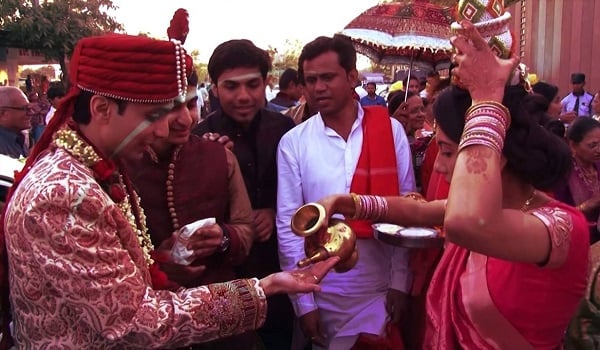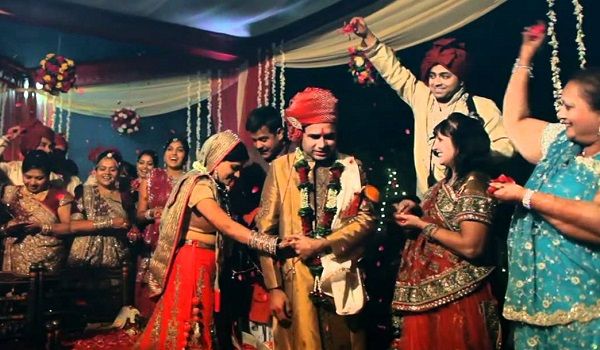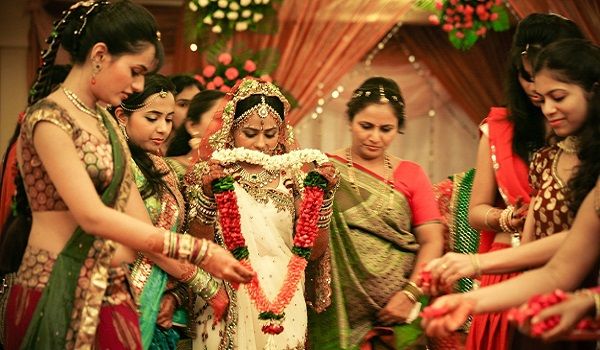Gujarat is known for its great culture, and delicious vegetarian food. All of these traits come together during a typical Gujarati wedding where the union of two souls is not just a bunch of ancient ritual, but a true celebration. There will hardly be a dull moment, with multiple pre and post wedding rituals, vivacious dancing and adherence to tradition. The sheer warmth of the hosts and their careful attention to detail for your comfort is sure to win your heart. It is a two or three day’s affair with multiple rituals observed through each day. If you can imagine a wedding full of fun and frolic without being over the top showy affair; then you must have experienced a true Gujarati Wedding. Let’s take a peek at the various Gujarati wedding traditions.

Pre-wedding Rituals
Chandlo Matli – This function is performed when the marriage gets fixed between the two families. Father of the bride along with four other male members of his family visits the groom’s home and applies Chandlo – a red circle made of vermillion at the center of the forehead. They bless the groom and offer him Shagun, a token gift.
Gol Dhana – The words Gol Dhana or Gor Dhana literally translates into Coriander seeds and Jaggery. This ritual is observed a couple of days before the wedding and is akin to the engagement ceremony in other cultures. The bride’s family visits the groom’s family and presents them with gifts of sweets and savories in traditional containers known as matlis. The bride and the groom exchange rings. Five married women, each from the bride’s and groom’s family, take turns and bless the couple-to-be for a happy married life. Generally a small feast is arranged for members of the two families.
Mandap Mahurat – This ritual is observed to officially kick-of the wedding. This is observed in both the bride’s and the groom’s places but separately. The priest performs a puja at the house especially praying to Lord Ganesha and seeking his blessings to remove all obstacles from the couple’s paths before their impending union.
Griha Shanti – This is also another puja performed by the priest to address all the obstacles presented by adverse planetary positions according to the bride and groom’s horoscopes. The priest offers appeasement to the Gods and seeks their assistance to smooth out any obstacle in the conjugal life of the couple-to-be.
Mehendi –The mehendi ceremony is generally observed two days prior to the wedding day. Henna paste is applied on the bride’s hands and feet in detailed intricate patterns. The initials of the groom are incorporated in the design somehow. Other women in the family also get their hands and feet painted with henna. Wedding songs are sung by women at the venue during mehendi ceremony.
Sangeet Sandhya or Sanji – This ceremony is observed during the evening a day prior to the wedding. Both the bride’s and the groom’s family come together at a common venue and perform songs and dance routines, especially traditional Raas or Dandiya and Garba dances. The ritual presents an informal setting for the two families to get to know each other well.

Pithi – This ceremony takes place separately at the bride’s and groom’s places separately the day before the wedding. The bride/groom sits on a low stool or bajat with their palms upturned, and a paste of turmeric, sandalwood, rosewater, herbs and mogra attar or perfume is applied to their face, hands and feet. The Pithi is generally prepared by the bride/groom’s paternal uncle’s wife or Kaki. The bride/groom is then bathed with water.
Mameru or Mosalu – This is an event where the groom’s maternal uncle or Mama along with his maternal aunt’s husband or Mousa goes to the bride’s house and present her with gifts like traditional Paanetar Saree, Jewelry, Wedding Bangles or Chooda made from ivory, sweets and dry fruits in beautifully wrapped boxes. This custom takes place the day before the wedding.
Jaan – The next ritual is known as 'Jaan' and it is performed to ward off any evil. It is quite interesting as the groom visits the bride place and touches his mother in law's feet to seek blessings.
Wedding Attire
The Gujarati Groom usually wears Dhoti and Kurta for the wedding day. Although modern day grooms also prefer to wear Sherwanis and other Indo-western Style Kurtas. They almost always wear a colorful, bandhni work dupatta around his neck. He almost always wears a matching turban on his head embellished with pearls and other precious stones.
The Gujarati bride typically wears a traditional saree which may either be a Panetaar or a Garchola on her wedding day. Panetar sarees are generally white in color with a bright red border typically made of gajji silk. The saree and the border are often embellished with zari threadwork and stone embellishment making the saree quite heavy. It is gifted to the bride by her maternal uncle. The Gharchola is usually a silk saree in rich red or maroon color with zari threads and bandhni work and is usually gifted from the groom’s side as a symbol of acceptance. The draping of the saree is typical for a Gujarati bride with the Pallu draped in the front fanned out over the blouse. The bride generally wears the Panetaar saree during the initial rituals of the wedding while she wears the Gharchola for the later wedding customs. She wears embellished bindis on her forehead over her eyebrows. The bride wears a host of jewelry to set off her bridal beauty like Gala no har, kan ni butti, Nathn), Bajubandh, with Bangadiand Patla, Chandlo and Chadda.

Wedding Day Rituals
Varghodo – The word refers to the wedding procession where the groom travels to the bride’s house. The groom arrives at the bride’s place on a horse and his relatives walk with him while dancing with music and band. Crackers are set off along with fireworks.
Ponkvu –This custom refers to welcoming of the groom by the bride’s family. The groom arrives and he is met with by the bridal party including the bride’s mother who performs and aarti, applies tika on his forehead and pulls him inside by trying to grab the groom’s nose which he playfully tries to evade.
Jaimala – During this ritual, the bride and groom are introduced formally for the first time. They exchange garlands twice, first time of which the groom has to stand on a stool so that he is standing on higher ground, and for the second round he steps down and they are on equal ground.
Madhuparka – After the Jaimala, the groom is led to the wedding mandap by his mother-in-law. His feet are then washed with milk and water. He is then offered a drink containing five sacred ingredients, milk, yogurt, ghee, honey, and sugar, known as the Panchamrut. During this the sisters of the bride try to steal the groom's shoes, known as 'Juta Churai'.
Antarpaat – The bride is led to the wedding mandap by her maternal uncle and an opaque cloth is placed between the bride and the groom to prevent them from seeing each other. This is known as antarpaat.
Kanya Daan – Before offering his daughter to the groom, the father of the bride washes the feet of the groom. He then places the hands of his daughter on that of the groom, thereby entrusting her happiness to him from now on.
Hasta Milap – The priest unites the groom’s shawl and end of the bride’s saree while chanting sacred verses from the scriptures. This along with the united hands of the couple is known as Hasta Milap.
Mangal Pheras – The bride and the groom, with their garments tied, stand up and make four circles around the sacred fire, each for the four goals of human life - Dharma, Artha, Kama and Moksha. The priest chants verses from the scriptures asking the couple to repeat them.
Saptapadi – The bride is made to touch seven betel nuts placed at regular intervals along a straight line with her right toe. The groom helps her during this task. The bride and the groom then recite the seven sacred vows during this ritual.
Sindoon Daan – The groom puts vermillion on the bride’s hair parting and ties the mangalsutra around her neck.
Kansar – The bride and groom feed each other with sweets at the end of the ceremony.

Post-wedding Rituals
Saubhagyavati Bhava – Seven married women are invited to bless the couple. While blessing the bride, these seven women utter the three words, Akhanda Sauvagyavati Bhava, meaning may your married glory remain forever.
Chero Pakaryo – A fun-filled ritual where the groom tugs at the saree of his mother-in-law as a way of asking the bride’s family for gifts.
Ashirwad – The couple ask for blessings from all the elders of both the families.
Reception – The reception is thrown in the honor of the newlyweds, where the relatives gather together for a feast. They come and greet the couple each offering a gift.
Vidaai – at the end of the reception, it is time for the bride to bid a tearful goodbye to her paternal residence and start for her husband’s house.
Ghar nu Laxmi – The bride finally reaches her husband’s house where she is warmly welcomed. She is considered Ghar nu Laxmi, or a bearer of luck and fortune for her family. The mother-in-law does her arti and applies tike to her new daughter-in-law. The bride enters the house after knocking down a vessel filled up to the brim with rice.
Aeki Beki – the newlywed couple is then made to play a game called Aeki Beki where several coins and a ring are placed in a tray of water covered by milk and vermilion. The couple has to find the ring from the vessel. It is believed that whoever finds the ring four times first, will be in control of the family.




